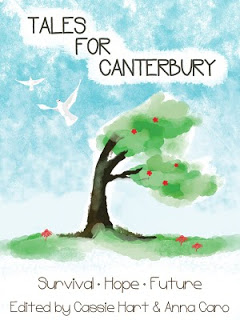Since the Christchurch earthquake of 22 February, editors Cassie Hart and Anna Caro have done an amazing job of pulling together Tales For Canterbury, a fundraising anthology to benefit the victims of the earthquake, with all proceeds going to the New Zealand Red Cross Earthquake Appeal. All the stories have been donated by their authors, and so far, just over half the fundraising target of $5000 has been raised – something you can help with by buying the book as an ebook or paperback.
I asked Anna Caro five questions about Tales for Canterbury, and here are her answers:
1. How soon after the February 22 earthquake did you have the idea for the anthology?
My original answer for this was “pretty quickly – within a few days”. Then I went back and checked my emails and found that Cassie emailed me with the idea only a few hours after the quake. Before I’d left work for the day the idea was already taking shape and we were contacting friends and people we’d worked with on other projects.
2. The list of contributors is impressive to say the least – a great range of New Zealand authors, and also such overseas luminaries as Neil Gaiman, Gwyneth Jones, Jay Lake, and someone whose story I’m especially keen to read, Jeff Vandermeer. How did you manage to get so many prominent speculative fiction authors involved in the project?
One of the things putting together Tales for Canterbury made me realise was how far our networks reached. Over the past few years both of us have been building up contacts through editing, events including conventions, involvement in SpecFicNZ and membership of critique groups, and we had a lot of people to call on when we needed them.
Our individual networks didn’t quite reach the name’s you’ve mentioned – but we knew people who knew them and were happy to get in touch with them for us. The exception is Neil Gaiman who Cassie (with a bit of encouragement) emailed directly after seeing he made a blog post mentioning the earthquake – his wife was in Christchurch at the time.
3. Tales for Canterbury isn’t all speculative fiction, though. Can you tell me about some of the literary and general fiction authors who have work included in this anthology?
Around two thirds of Tales for Canterbury is speculative fiction of some description, but we have some excellent examples of literary or general fiction. Amongst the authors are Kate Mahony, who I first met in an undergraduate class at the IIML, Janis Freegard who lives in Wellington and I knew primarily as a poet and of course yourself (Tim Jones), and subjects range from being a New Zealander overseas, through misfit and eccentric characters to an imagining of life after the earthquake.
I think the fact we imposed only quite broad restrictions on what we were looking for encouraged writers to submit work outside of their usual genre, and several – including Mary Victoria, Philippa Ballantine, and my co-editor, Cassie Hart – who are primarily known for speculative fiction contributed more realistic pieces of work, though the influence of the genre is often apparent. The technology in Mary Victoria’s ‘Daughter of the Khan’, though historically accurate, is perhaps even more frightening and magical to the characters as an alien ship might be to us – and she makes us believe it.
Also worth mentioning here is A.J. Fitzwater’s ‘My Father, the Tuatara’, which I would describe as magical realism, a genre frequently claimed as both speculative and literary fiction. Throughout the story, you’re never quite sure whether this is an elaborate metaphor, or a fantastical event, which handled with less skill could be jarring, but here is poignant and thoughtful.
We also have a couple of stories from other genres; I hope there is something everyone will appreciate included.
4. The anthology is divided into three sections – “Survival”, “Hope” and “Future”. Did you have that division in mind from the start, or did the stories you received naturally fall under those headings?
It came quite early on. We wanted to give the anthology some form of structure, but nothing that excessively limited the stories we included. We played with a few ideas and ended up with this one which mirrored, if in a simplistic way, the stages of a recovery. There were a number of stories that fitted quite naturally under more than one of the headings, and a couple we had to think about a bit before placing them anywhere but I hope the categorisation we ended up with adds something to how readers think about the stories.
5. I know from my own experience how much work goes into co-editing an anthology, let alone publishing it. You’ve taken an anthology from nothing to completed and published in three months. How on earth did you manage it; have you been able to keep your own writing going during the process; and what lessons have you learned from the experience?
To put it succinctly: with lot of help. I admit we struggled at times but we had so many people helping out behind the scenes, be they our team of volunteer proofreaders, who got through a section each on a very short timeframe, or those who brought us caffeine when we’d been up far too late. There were some circumstances in our favour; in particular, the fact a number of the stories were reprints meant many needed close editing. We also decided early on that the anthology needed to be invitation only; in the past I loved reading work by authors new to me, but in this instance we just weren’t able to handle a large slush pile.
I think at times our own writing did suffer for both of us, but within a week of Tales for Canterbury being sent to the printers, both Cassie and myself independently sat down and just wrote, so the damage was definitely temporary – and in any case, I think editing, closely reading other people’s work, really does help in the long run.
Lessons? After the previous anthology I edited I had all these bright ideas for improving things, and then when Tales for Canterbury came up I implemented some, but many just got lost in the tight timeframes. So I guess the fact that every project is different would be a lesson. On a personal level, though, I think the biggest lesson I learned was about sharing responsibility. I’m hopeless at delegating, but working with Cassie, who is superbly committed and reliable, and the effects of both having otherwise busy schedules, helped to change that. We passed things back and forth, one picking up when the other was busy, and swapping tasks when things just weren’t happening, and having that very positive experience has, I’m sure, taught me a lot about taking a step back and trusting other people to get it right.

